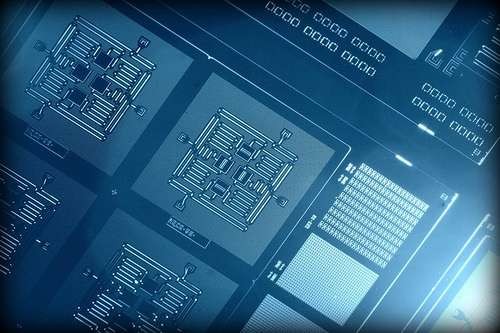IBM Starts to Build Reliable First Practical Quantum Computers
| Marco Foronda | | Apr 30, 2015 03:40 AM EDT |
(Photo : IBM Research) Layout of IBM's four superconducting quantum bit device. Using a square lattice, IBM is able to detect both types of quantum errors for the first time. This is the best configuration to add more qubits to scale to larger systems.
IBM scientists today unveiled two critical advances towards the realization of a practical quantum computer. For the first time, they showed the ability to detect and measure both kinds of quantum errors simultaneously, as well as demonstrated a new, square quantum bit circuit design that is the only physical architecture that could successfully scale to larger dimensions.
Like Us on Facebook
Quantum computing can be regarded as a means to advance computing further than today’s PCs and servers. It is amongst the methods to advance computing once it can be physically and economically unrealistic to develop more compact, much stronger chips based upon silicon and standard techniques. Quantum computers employ elements that happen to be distinct from the ones applied by typical computers.
Two types of errors can occur on such a superposition state. One is called a bit-flip error, which simply flips a 0 to a 1 and vice versa. This is similar to classical bit-flip errors and previous work has showed how to detect these errors on qubits. However, this is not sufficient for quantum error correction because phase-flip errors can also be present, which flip the sign of the phase relationship between 0 and 1 in a superposition state. Both types of errors must be detected in order for quantum error correction to function properly.
IBM is now able to identify a variety of data errors simultaneously in a square array of four qubits, which was not formerly attainable. In this case, IBM was able to detect bit-flip errors, which entail a switch from a zero state to a one state or vice versa-which will also be relevant to conventional chips-and also phase-flip errors, and could be applied to superpositioned qubits.
It is important to correct errors thanks to the complexity of quantum computing and the fragility of the interaction among qubits, but it can also been considered as a challenge. At the moment, research is inclined towards limited sets of qubits, but IBM intends to bring error correction to larger systems, says Jay Gambetta, manager of IBM’s quantum computing and information group.
Because these qubits can be designed and manufactured using standard silicon fabrication techniques, IBM anticipates that once a handful of superconducting qubits can be manufactured reliably and repeatedly, and controlled with low error rates, there will be no fundamental obstacle to demonstrating error correction in larger lattices of qubits.
Gambetta declined to calculate when a universal quantum computer would come out, saying it’s a long journey that many researchers are working toward.
Details of the new study published in the journal Nature Communications.
TagsIBM Starts to Build Reliable First Practical Quantum Computers, Quantum computers. Quantum computing, quantum errors, Qubits, superconducting qubits, personal computers, servers
©2015 Chinatopix All rights reserved. Do not reproduce without permission
EDITOR'S PICKS
-

Did the Trump administration just announce plans for a trade war with ‘hostile’ China and Russia?
-

US Senate passes Taiwan travel bill slammed by China
-

As Yan Sihong’s family grieves, here are other Chinese students who went missing abroad. Some have never been found
-

Beijing blasts Western critics who ‘smear China’ with the term sharp power
-

China Envoy Seeks to Defuse Tensions With U.S. as a Trade War Brews
-

Singapore's Deputy PM Provides Bitcoin Vote of Confidence Amid China's Blanket Bans
-

China warns investors over risks in overseas virtual currency trading
-

Chinese government most trustworthy: survey
-

Kashima Antlers On Course For Back-To-Back Titles
MOST POPULAR
LATEST NEWS
Zhou Yongkang: China's Former Security Chief Sentenced to Life in Prison

China's former Chief of the Ministry of Public Security, Zhou Yongkang, has been given a life sentence after he was found guilty of abusing his office, bribery and deliberately ... Full Article
TRENDING STORY

China Pork Prices Expected to Stabilize As The Supplies Recover

Elephone P9000 Smartphone is now on Sale on Amazon India

There's a Big Chance Cliffhangers Won't Still Be Resolved When Grey's Anatomy Season 13 Returns

Supreme Court Ruled on Samsung vs Apple Dispute for Patent Infringement

Microsoft Surface Pro 5 Rumors and Release Date: What is the Latest?










